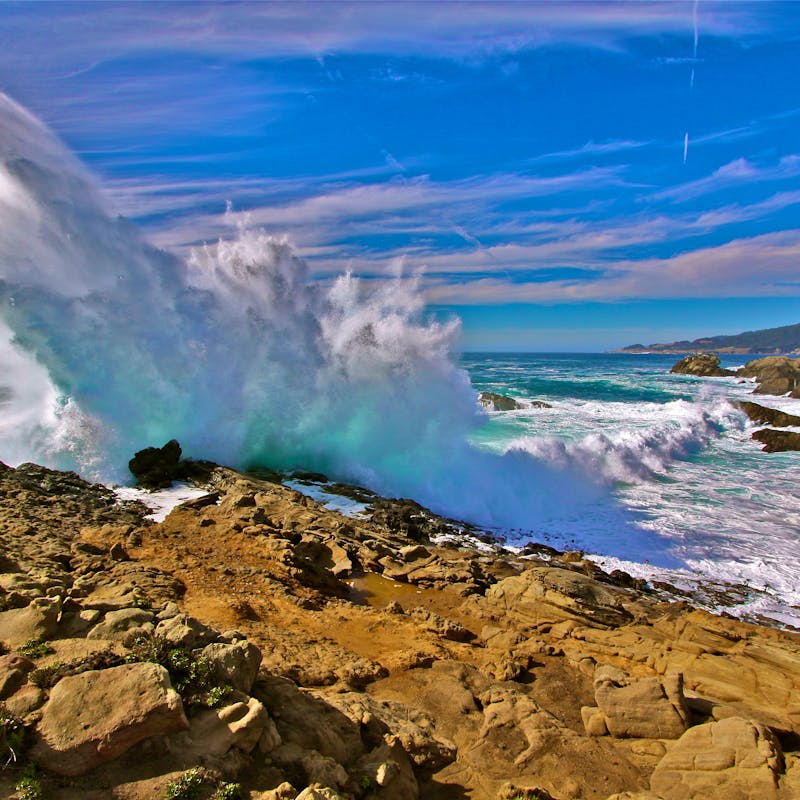Whales have captured imaginations for centuries, whether through calls from the deep or sightings off our shores. Katherine Sayler, Southeast representative, answers common questions about whale watching from Florida up the Atlantic coast and shares why watching for the North Atlantic right whale is not only fun, but important to the species’ survival.
Q: Where can whales be seen off the Atlantic coast?
The North Atlantic right whale, humpback, fin (Western North Atlantic stock) and minke whales can all be found off our Atlantic coast, with a variety of opportunities available to watch for one to poke out of the water. Even in Florida, a state rarely associated with whale viewing, there is the opportunity to see one of North America's most endangered large whale species: the North Atlantic right whale.
Since 2018, annual estimates of North Atlantic right whale populations have hovered between 360 and 380 whales, down from 483 in 2011. Since 2017, this whale has been affected by an Unusual Mortality Event, which refers to a significant die-off that defies prior records. Those 360 to 380 whales traverse waters along the whole length of our East Coast and north into the Canadian Atlantic.
Q: How can we count right whales if there are so few?
Whales are counted via aerial surveys using drones and aquatic gliders, as well as daily flights (as done with manatees and other species during calving season). Adult right whales can be distinguished by their callosities, the bumpy patterns on their heads that are as unique as fingerprints. Unfortunately, many also bear unique scars from surviving vessel strikes and/or fishing gear entanglements that can also be used to tell them apart.
Scientists use passive acoustic monitors like hydrophones to hear sounds deeper than 100 meters. These powerful tools can be either stationary or mobile and used for longer-term monitoring.
Whales are also reported by vessels of many shapes and sizes, including research vessels, commercial ships, fishing vessels and the Coast Guard. Community scientists, however, conduct surveillance from shore with binoculars. Boat collisions are a major risk to these whales, so viewing them from shore is the most responsible and ethical way to see them.
Q: Where do community scientists watch right whales in Florida?
The Marineland Right Whale Project has provided northeast Florida with stewardship and science for 25 years. Staff are on the ground (and in the air) in Florida every calving season, even though the program is run by the Associated Scientists at Woods Hole, Massachusetts. From January to March, over 200 volunteers donate around 7,000 hours to daily surveys, working to spot whales from shore. Project volunteers sighted or responded to 15 right whale sightings in 2025, including six of the 10 known mother-calf pairs. In April, another group identified an 11th mother-calf pair off Cape Cod.
Amelia Island Whale is located in the northeastern corner of Florida in the heart of the calving grounds that extend from Florida to the Carolinas. It also hosts community scientists who look for whales and train others to identify them from the beach. The group brings educational presentations to schools and community groups, speaking to over 1,600 people in the last three years. Although relatively new, its impact is mighty.
Q: What should boaters know about whales?
Boaters in all coastal waters should watch for V-shaped mist from blowholes or signs of feeding whales. By federal law, boats must keep at least 500 yards away from whales for the safety of boaters and animals alike. Sightings can be reported from Maine to Virginia by calling (866) 755-6622 and from North Carolina to Florida at 877-WHALE-HELP. Right whale sightings anywhere may also be reported to the U.S. Coast Guard via communications channel 16.
Boats of any size can kill or injure a whale, but current regulations only require slowdown to 10 knots or less for vessels over 65 feet in seasonal management areas from Cape Cod Bay to parts of Georgia and southern Florida. Voluntary “slow zones” from Maine to Virginia can also be triggered for vessels of any size when three or more right whales have been sighted in an area. Slow zones are selected based on visual sighting data and information from powerful acoustic devices, and can be found using NOAA’s right whale sightings map or by downloading the free Whale Alert app.
Q: Why is it important to report whale sightings?
In 2025, two adult female right whales made an unusual journey that started typically: 16-year-old Koala and 14-year-old Curlew traveled together from South Carolina to northeast Florida. They then continued down the coast past Miami and around the Florida peninsula, reaching Alabama before heading back to the northern Gulf near Destin around April 1. By April 15, they became the first-ever members of their species recorded in the Bahamas. By early June, they were back in the Gulf of St. Lawrence, Canada, completing an over 5,000-mile journey spanning three countries.
Tracking of these whales’ paths was primarily made possible by mariners and members of the public who reported sightings. Koala and Curlew are just one example of the importance of crowd-sourced and community scientist-contributed data.












